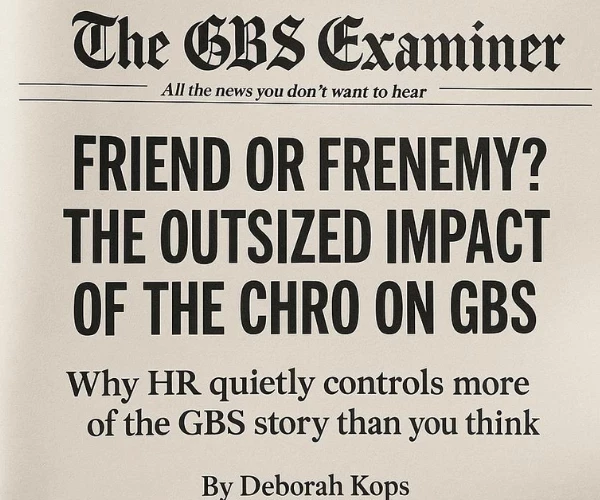The New 'Science Fiction' World of Shared Services
Add bookmark
I hardly recognize shared services anymore. That was my overriding thought throughout the four days that made up the 21st North American Shared Services and Outsourcing Week in Orlando this month. That's not to say that I don't recognize the people, because, hearteningly, there are long careers in this industry. In the decade-plus that I've been attending this conference I've been delighted to see many of the same people, albeit with expanded roles or new badges, and always pushing the envelope.
Many of these same folks are now up on the stage, sharing how they are redefining their shared services model to account for the new digital landscape they suddenly find themselves in.
We’ve certainly come a long way in two decades. While the original driver for shared services was, of course, cost effective delivery, with most of the ‘low hanging fruit’ picked years ago, what we are now seeing is a renewed focus on getting the house in order. SSO leaders are worried about how to keep on contributing value. We already know that most of the relevant enterprise data [according to P&G's former CIO and President of GBS, who also presented, it’s all the relevant data] runs through shared services. So what does this mean? Well, it's a call to action: Don't just process fast and reliably and cost-effectively (that is a given). Today, you are being encouraged to hire some of the many data nerds that universities are churning out [‘Data Analyst’ is now regularly rated as one of the top most lucrative jobs] to look at the ‘what else’ part of the equation. And here we are talking about analyzing real-time data and information, even incorporating the unstructured stuff that surrounds us – not just internally but also externally.
If it sounds like science fiction, well, it is, a bit. And the really exciting thing is that you are in the midst of it.
To explain the science fiction part, SSON’s producers invited ‘futurist’ Martin Ford, author of ‘Rise of the Robots’ [If you haven't already got it, rush to get it now! I treasure my autographed copy] to provide us with a broader context of the digital environment. Much of it was sobering but some of it reassuring. So, as much as we fear the disappearance of traditional jobs, statistically, the majority of jobs that were around in the ‘70s are still around today. However, while productivity and hourly compensation rose in tandem in the early part of the 20th century, for the past 40+ years there has been a significant splitting of paths: Productivity, driven by automation, continues to rise but hourly compensation has stayed flat. In other words: Workers are becoming less ‘valuable’ and this disruptive force, Martin says, has led to Brexit, Trump, and the general frustration of working people everywhere who are simply not participating in progress. Not even a specialized degree can save you, for a while robots have been building cars for decades, today we also see bookkeeping, radiology, and corporate finance work being replaced by software. In other words, there is no correlation between level of education and job security. And that, my friends, could apply to any and all of us.
According to Martin, the solution for the ‘human’ – as opposed to the ‘digital’ – element of the workforce will be to focus on creative work of the kind that involves deep interaction with other people. That’s the kind of work that will be in demand in an environment driven largely by technology and automation. It may even mean that in future we, as a society, do less work and have more time for our private lives – but that is all way ahead of us. In the meantime, there are still services to be delivered!
So, what we need right now is a new operating model to account for the digital world.
 The overall trend of shrinking manual work while at the same time artificial intelligence is driving more capacity your way means that you will need to be prepared to introduce changes, warns Brad DeMent, conference chair and Partner at ScottMadden [read his list of 10 trends shaping the industry here].
The overall trend of shrinking manual work while at the same time artificial intelligence is driving more capacity your way means that you will need to be prepared to introduce changes, warns Brad DeMent, conference chair and Partner at ScottMadden [read his list of 10 trends shaping the industry here].
ScottMadden’s own research has identified SSO ‘leaders’ as being able to do work with five times as few people in F&A services; and 1 1/2 times as few people in HR services than standard shared services. "When you add artificial intelligence into the mix this advantage will only grow" he says.
Manny Korakis, CFO, S&P Dow Jones Indices, was refreshingly candid: there should be no transactional accounting in the business unit; all that should be taken care of within Finance shared services or a Center of Excellence. Business units, he says, need to be freed up to think strategically. Of course, cost of operations is still the elephant in the room but artificial intelligence is now driving a phenomenal pace of change, and given all the data shared services has access to, the way to truly evolve the model, he says, is by introducing and leveraging technology that drives more value. With process defined by GPO's, and systems delivered by IT, the opportunities for being innovative in driving value have been somewhat limited, however, with little flexibility in either direction. The emergence of robotic automation changes this.
Robotic automation is, of course, the hot theme of the day. We are not just talking robotic process automation (RPA), but also related learning, server-driven and predictive iterations. [We need to watch our language, by the way, as Lee Coulter reminds and admonishes us: ‘RPA’ is being used as a convenient sweep-all and is too often used in error. We need to start differentiating between desktop automation, process automation, and server driven automation, as well as acknowledging the integration of cognizant and artificial intelligence. You’ll find us increasingly referring to Intelligent Automation, which is a more appropriate umbrella term.]
Simen Munter, previously head of ANZ's GBS operation, which incorporates the innovative robotics group [this team won the 2017 Excellence Award for Automation, by the way] explains that the strategy that proved most successful at ANZ was deploying lots of smaller pilots widely as opposed to a single big project deeply. Simen also advocates the happy path of automation, treating automation as an ‘honored guest’ and giving it only the ‘best bits’. "All the easiest things should go to the robots – that's where the big wins are," he says. Simen also reminds us that the embedded analytics of RPA provide valuable real-time information.
The concept of month-end analysis needs to disappear completely, adds Automation Anywhere's cofounder Mihir Shukla. With the digital workforce potentially five times as productive as the human workforce at one fifth the cost, it's going to significantly shake up sourcing models. One of the most exciting aspects of this new development is that analytics will happen at the front end, not the back end; and the ability to add in a cognitive element is the first step towards managing the vast amount of unstructured data that surrounds us. It's welcoming in a new processing paradigm, Mihir and Simen both agree.
The jaw-dropping awesomeness of robotics was made very clear to a packed hall on the second day of the conference, when Automation Anywhere's co-founder and CEO Mihir Shukla launched the #GreatBotRun on the main stage. What Mihir illustrated was simply this: that if you take the entire work load of ATM transactions done across the US in a year, and transferred that work to robots, transaction time simply melts away. Within less than 48 hours, 34.5 million transactions were processed – the equivalent of 1.3 million human work hours worth of work [see slide below]. "This isn't about one specific company, but rather it's about the changing nature of work," explained Mihir. [As a side note: Mihir offered a prize to the person who most closely guessed the number of transactions that would be processed within 48 hours – no surprise that MasterCard's Jordane Elmassian came closest. He knows a thing or two about data processing!]

Shared services is in a unique position to leverage modernization by acknowledging where investments are needed, based on emerging solutions that offer multiplier effects. Tim Westendorf, Senior VP, Group Head Financial Systems & Shared Services Strategy at MasterCard, emphasizes the value of visualization solutions to transform the inherent value of data sitting within ERP. MasterCard makes broad use of a data insight platform called Tableau – a frequently referenced solution that creates dashboards showing real time and live data. Alteryx was also often mentioned as an exciting new complementing solution [“Tableau on steroids”] that can act as a springboard to advanced analytics.
A valuable piece of advice that we heard a few times across the four days was that you may as well make IT your partner – “otherwise they’ll only slow you down” [plus the truth is you will need them when, not if, things go wrong].
One relative ‘newbie’ on the block [forgive the pun] is block chain. Although most people around the room still looked puzzled at its mention, the point was made again and again: block chain is going to become part of your service delivery language so study up now!
What is it? In essence, block chain describes a block of data that you can trust, and use again and again, without requiring additional outside information or validation each time. It's the trusted interface between two parties that enables a transaction – but it effectively does away with the role of the middleman and therefore opens the door to instant, real time peer-to-peer transactions. This trusted ecosystem defined by ‘one version of the truth’ offers obvious opportunity to procure-to-pay as a number of speakers agreed.
One of the biggest attractions of the week was the presentation by Filippo Passerini, previous recipient of SSON’s Thought-leader Award for his work at P&G’s GBS, which is generally held up as the ultimate poster child for what shared services can do [Filippo’s career culminated in CIO, and President of GBS]. The success that Filippo drove through GBS at Procter & Gamble was based on the right sequence of events, he says, whereby the key was to focus on being distinctive and relevant by supporting the business in its objectives.
"The important thing is to prevent the GBS from becoming a commodity, because then it’s just about cost,” he warns. Filippo’s background as line manager helped him bring a business mindset to the shared services group, based on “don't run faster – change the way you run!” At P&G, GBS’s success was based on strategic alliances which have been “a gold mine” for the group, he explains. The other key performance driver was embracing “go digital” – not just as a social network but as a means of running the business faster and better.
A final tip he shared is to make change a strategy for how business is done: At Procter & Gamble, Filippo found that the organizational design became obsolete every 36 months and he grasped the opportunity to reinvent it. Doing this, therefore, enabled him to inject a number of changes at every round. It also meant the organization had renewed trust in shared services, because there was a new solution.

Another leading trend was highlighted in what might have been the most popular panel discussion [see photo on left], which delved into the challenges of managing multi-generational teams and providing sustainable, valid career paths: industry veteran Deborah Kops, who has sat on both sides of the shared services and BPO divide, invited three SSO leaders [in honor of International Women's Day, the panel was nearly exclusively female] to talk about talent, Millennials, and leadership [later in the day, and to everyone’s entertainment, a speaker asked “How is it that we have suddenly become more accepting of robots that we are of Millennials?”]. It was a sparky conversation with Cindy Gallagher from Discovery pushing for blue jeans and off-site working; Vesta Bovair from Swiss Re exploding the leadership myths that characterize blueblood European corporations; and Philip Woodburn from Schneider Electric warning that the UK ranks #28 in global educational skills, and that the talent coming out of Hong King, China and India is enormously impressive. [If you missed this panel don't fear, you'll have the opportunity to listen in again next month, at SSO Week North America’s digital event – the 10 most popular sessions presented again online].
 HR leaders are certainly proving themselves at the front of the game in understanding the value of robotic automation. Last year, in what was generally acknowledged as one of the first industry implementations of RPA in HR Services, the team from EMC walked off with not one but two Excellence Awards! This year, Walgreens’ Curt Burghardt, Senior Director, HR Shared Services, highlighted the fact that RPA presents a tremendous opportunity for HR. Right now, the strategic conversations are missing in HR – especially in light of the fact that the needs of tomorrow's employees are completely different to those of today, he says. By freeing up HR services delivery staff from transactional activity, robotics will catapult HR’s capability to take on the higher value kind of work that's being missed currently, he says. And he issues a stark warning: "If you don't adopt RPR soon, you'll be at a competitive advantage in a few years."
HR leaders are certainly proving themselves at the front of the game in understanding the value of robotic automation. Last year, in what was generally acknowledged as one of the first industry implementations of RPA in HR Services, the team from EMC walked off with not one but two Excellence Awards! This year, Walgreens’ Curt Burghardt, Senior Director, HR Shared Services, highlighted the fact that RPA presents a tremendous opportunity for HR. Right now, the strategic conversations are missing in HR – especially in light of the fact that the needs of tomorrow's employees are completely different to those of today, he says. By freeing up HR services delivery staff from transactional activity, robotics will catapult HR’s capability to take on the higher value kind of work that's being missed currently, he says. And he issues a stark warning: "If you don't adopt RPR soon, you'll be at a competitive advantage in a few years."
[inlinead]
At Walgreens, potential processes are evaluated based on whether additional process changes are required to implement RPA. If yes, it’s not a good candidate. The easiest fit for robotics is in “if…then” types of rules – for example FMLA eligibility, where three key questions are today answered by a robotic software solution. Other obvious opportunities for HR include PTO accrual and calculations, leave of absence notification to managers, payroll location changes and benefit eligibility hours updates. Another piece of advice from Curt: Don't let ‘perfect’ be the enemy of ‘good’. Perfection is your enemy, he tells us.
As far as the Holy Grail of shared services models, Global Business Services, is concerned, today the structure that tends to outweigh most others is one of transactional centers supported by specialist support centers/centers of expertise. As Rodney Bergman, SVP GBS from Celestica, points out, where GBS is still seen as an organization, not an operating model, true benefits are elusive. Once you past that and GBS is recognized as the operating model that it is, its strengths will be felt immediately.
Right now, Rodney says, GBS is struggling with the fact that it is not flavor of the month any more. It's become part of the fabric of the enterprise but it has not necessarily been given a seat in board meetings. To be relevant [a word emphasized again and again by P&G’s former Group President, GBS, and CIO, Filippo Passerini] GBS will have to bring information relative to enterprise wins and losses that directly support growth strategies. “You have to constantly maintain your relevance through real-time data that directly impacts business success, and bring insights back to the steering committee,” Rodney reminds us.
So finally...
Shared Services and Outsourcing Week is always a team event. What makes it the success it is, year after year, the extraordinary collaboration between our producers – Heather King and Sally Fletcher – our marketing team, the sponsorship team, and, most importantly when we are finally on site, the phenomenal operations team. To close off I'm sharing a team photo of the SSON group that makes it happen. We are already looking forward to the European Shared Services and Outsourcing Week in May [Manchester – get your tickets now!] Followed by Australia, Asia, etc. you can find all of our global events online here.























